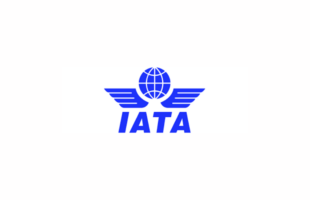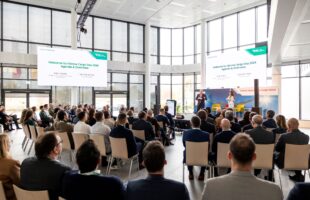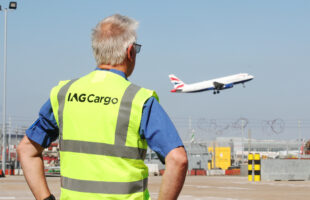E-freight: Has its time come?
It would be fair to say that things have never looked better for the much maligned, heavily criticised and quite frankly, often misunderstood, e-freight initiative. With increasing buy-in by carriers, governments, freight forwarders and a number of global and local organisations actively promoting it, e-freight suddenly appears to have been shifted into higher gear. Donald Urquhart reports from Geneva.
No doubt plumped by the relatively rapid success of e-ticketing on the passenger side, the move to swiftly transform the cargo side of the business by “taking the paper out of cargo” was heralded with much fanfare in 2005 by then International Air Transport Association (IATA) CEO Giovanni Bisignani. In true Bisignani-style, the announcement of the initiative bordered on the theatrical as he announced a “clear mandate” from airline CEOs. The bid to go paperless would see 265 airlines and more than 150,000 freight forwarders plunge head-long into the task to purge the industry of paper by 2010, he said. The promise of ‘IATA e-freight’: US$4.9 billion in annual cost savings, a reduction in transfer time by 24 hours, fewer errors, online tracking and tracing, and a gift to the environment by eliminating 7,800 tonnes of paper documents with enough volume to fill 80 B747 freighters. Fast forward nearly seven years and the reality doesn’t quite match the vision. As at the beginning of December e-freight is live in 43 countries and 7.5 per cent of global trade lanes with 100 airports, 42 carriers and just 400 forwarders using e-freight to some degree around the world. And e-freight volumes form only a fraction of total global volumes, somewhere around three per cent. Push factors And while this situation is a far cry from the original goal of full implementation by 2010, a number of developments have taken place in the last year that appear to have reignited the spark behind e-freight. Although not directly connected to e-freight the Yemen printer cartridge bomb “changed the rules of engagement” in the words of Ram Menen divisional senior VP for cargo at Emirates Airline. That incident threw the industry into a security tailspin that ultimately saw a turn towards intelligence-based cargo screening that relies on just the type of information e-freight is all about. IATA is currently finishing its work on the e-Security Declaration which it is anticipated will become a key e-freight document as the US and other countries turn to intelligencebased cargo screening. “Information is very key and on the e-freight side, being able to provide the information to the security agencies well ahead of the transportation cycle and being able to profile and clear cargo for transportation is very, very key to removing hurdles in the supply chain,” Menen said. E-freight is also one of the key pillars of the Secure Freight project currently being piloted by IATA, he added. The next very big push came from the unprecedented coming together of the major air cargo supply chain-related industry groups – the International Federation of Freight Forwarders Associations (FIATA), The International Air Cargo Association (TIACA), the Gobal Shippers Forum (GSF) and IATA – to form the Global Air Cargo Action Group (GACAG). The raison d’être being the creation of a platform for dialogue and problem solving around key industry issues and to present a true unified supply chain voice to regulators around the world. Indeed the forum has already proved useful at smoothing over the often terse relations between forwarders and IATA. And crucially, within GACAG a number of task forces have recently been formed, including an e-commerce group whose initial task is to help facilitate the implementation of e-freight. Another lower-key, but widely acknowledged factor within the industry was the appointment of the former head of Etihad Crystal Cargo, Des Vertannes, as global head of cargo for IATA. Widely respected amongst both carriers and forwarders, his appointment helped thaw the deep chill that had set in between IATA and freight forwarders. Indeed, shortly after taking over the post he told Payload Asia that it would never again be described by his organisation as ‘IATA e-freight’ for the simple reason that for it to succeed, it had to be recognised as an initiative with industry-wide ownership and not simply an IATA product. And so, the general consensus across the supply chain is that e-freight is not only inevitable, it is also the right way to go. But on how to get there, the unified voices become somewhat less coherent, but still a far cry from the clearly discordant viewpoints previously. Forwarders onboard Only a few years back at the FIATA annual meeting in Vancouver, then FIATA president Bill Gottlieb held the firebrand high declaring that, “IATA e-freight will not happen in my lifetime”. Dramatic rhetoric for sure, but his statement summed up the views of his community who simply saw the initiative as yet another IATA programme being thrurst upon them with little or no consultation. Worse still, they anticipated added costs to become e-freight enabled without any of the cost savings – with only the carriers reaping the rewards. While some of these doubts remain, the tide is clearly turning. Not only has the acerbic rhetoric of the forwarders virtually vanished – with scarcely a negative word uttered at FIATA’s recent AGM in Cairo – but the e-freight task force under GACAG is headed by none other than Bill Gottlieb. “There has certainly been a change within IATA and Des started that rolling and we’ve also had a few discussions with Tony Tyler and he is acutely aware of the successes and challenges and willing to work with the broader industry that will drive the efficiencies that everyone is looking for,” Gottlieb told Payload Asia in Geneva. “There’s still a lot of work to be done, but certainly it opens the door for better dialogue and GACAG has given us a tool to do that so we’re finding that we’re able to start looking outside the box as first steps – we’re not trying to build a whole new model but certainly wondering if we’re going the right direction or can we enhance the direction we’re going,” he said. One of the issues identified very early on by participants was the fact that the paper air waybill (AWB), in existence for nearly four decades, was being converted to an e-format without questioning what that document should be today, what data elements should be included, something Gottlieb believes should be reviewed. “How do we devise a standard message of data elements that will provide as much efficiency as possible by pushing that data out quickly” he asks. The other idea put forward by the forwarders is the question of, “why the forwarder should be responsible for putting together the air waybill anymore in an electronic environment. All we have to be responsible for is providing the data and the airline will validate that data against its acceptance procedures and the airline will provide us with an electronic AWB which will be executed only when the cargo is received. It just makes common sense. In that way we are no longer an agent of the airline doing the documents on behalf of the airline,” he says. “We want to look at the whole traditional relationship between forwarder and carrier which was one of agent and principle – to what is in most markets that of customer and vendor – and I think by taking away the responsibility of preparing the AWB on behalf of the carrier you certainly realign the relationship.” Gottlieb notes that the response from IATA has been good, but adds, “we are very much in a dialogue here and trying to think outside of the box. And I’m sure there will be other considerations.” A complicated process Proponents of e-freight, while acknowledging that it has not taken off as fast as originally envisaged, are upbeat on its business case and the progress made so far in setting the stage for implementation. Vertannes emphasises that those who have been critical of the limited success to date should look at the first three years from the correct perspective. “The first three years were about building the actual network and infrastructure that could facilitate e-business and e-freight.” This included creating the industry business processes, e-freight operating procedures and perhaps most crucial of all, the e-document standards for converting the paper documents to e-format. Without a doubt it was and remains a difficult and challenging process and perhaps, as many point out, IATA was overly optimistic in the early days and “bit off more than it could chew” as one Australian freight forwarder commented. Originally the aim was to tackle the 20-plus documents typically involved in an air cargo shipment, but this has since been reduced to a more manageable focus on a core dozen or so documents. No one knows the challenges better than IATA’s head or cargo e-business, Guillaume Drucy. He notes that in developing the e-freight model it was understood that to make it effective across the whole air cargo supply chain it needed to be viewed as an end-to-end process. This process he says, involved three very broad pillars starting as a core base, the presence of an electronic customs and regulatory environment that supports the industry operating on a paperless basis. This means the country must be a signatory to either the Montreal Convention 99 (MC99) or its associated document the Montreal Protocol 4 (MP4). The next pillar involves electronic communication between the forwarders, the airline and the ground handling agent. This is where the core transport documents come into play including AWB, house AWB, flight manifest, etc. This portion includes the most processes and also includes the physical transfer of cargo. The last pillar is the electronic communication between the origin and destination forwarders, as well as shipper and consignor. In their paper form, these documents travel with the cargo in pouches, but have no relevance to the carrier or ground handler, he notes. Enter the e-AWB Another key push factor for e-freight was the development of the electronic air waybill (e-AWB), which only recently made its debut. While critics point out that the e-AWB can be seen as an acknowledgement of the some of the failures in the e-freight development process because of its appearance as a sort of ‘after-thought’ document. They also highlight that it gives an illusion of growing e-freight success because it is a contract between carriers and forwarders and avoids the more complicated tangle of customs and other regulatory issues related to the larger process of e-freight. But Frederic Leger, head of IATA’s cargo business process and standards, begs to differ, pointing out it has been in development since the overall e-freight programme began and was in fact developed with the industry – in particular FIATA – from about 2008. “When we started e-freight we were also working on the e-AWB, but it took us quite a bit of time to come up with the right standard, so the project team started to work on e-freight with this piece missing in the puzzle,” Leger explains. “Now that we are ready on the startup side we are pushing aggressively the implementation of the e-AWB to catch up what has been done on e-freight and in 2012 the e-AWB will become mandatory.” So far the e-AWB has been tested in eight countries by nine airlines in 2010 with the aim to reach 100 per cent e-AWB on all feasible trade lanes by 2014. As at the end of 2011 the e-AWB penetration sits at just over three per cent. The e-AWB can be used in lieu of the paper AWB in any country that is a signatory to either MC99 or MP4, as well as any of the 43 e-freight countries. The remainder follow the Warsaw Convention which requires a paper AWB. One of the benefits of now having the e-AWB in the e-freight arsenal, is that it is a core, yet easily accesisble component that can help demonstrate the benefits of e-freight, says Drucy. “As one of the core documents for the industry and out of the 12 documents that e-freight has taken on as its scope, it is the one where we think there can be a lot of progress made in a fairly short period of time. It is also a very good starting point for people who are not yet doing e-freight to unlock and see the benefits,” he says. Tangible progress It’s clear that real progress is being made, despite the seemingly tiny volumes that are moving via e-freight compared with those moving along the traditional paper trail. “The growth is painfully slow but then again if you compare the inputs we’ve put in over the last 20 years or so, the recent pace is fast in comparison,” notes Menen. “Whatever we’re going to see over the next two, or three, or four years is going to be a nanosecond in terms of the entire evolution of the industry itself,” he adds. Saying he is pleased with the e-freight developments and the fact that it is finally gaining traction, he says Emirates SkyCargo has essentially taken a similar strategy as Hong Kong’s Cathay Pacific and gone 100 per cent e-AWB out of Dubai. “In Dubai we don’t accept any paper documents for exports and even for imports we don’t deliver with any paper AWBs – we email the delivery orders and other documents to our customers – so basically 100 per cent no acceptance of paper air waybills,” he says. And for those destinations which do not accept e-AWBs, SkyCargo simply prints out a paper version at destination. “Emirates is a huge advocate of e-freight and is already one of the leaders in the industry in actual numbers of shipment carried on the e-freight lanes,” said Menen. “The benefits it has brought our business are enormous, which is why we are encouraging others to embrace it. E-freight is the future of our industry. “In 2010 alone, SkyCargo carried nearly 30,000 international e-freight shipments – more than any other carrier. “We are definitely in the lead at this point of time. Our penetration rate on e-freight lanes at the beginning of 2011 was at about 12 per cent and we’re already at 17 per cent at the moment so that’s going pretty good.” Aside from carriers like Emirates and Cathay, major freight forwarders like DHL Global Forwarding are also major proponents and active users of e-freight. So too are airports and civil aviation authorities like Amsterdam Schiphol Airport, Incheon Airport and the Civil Aviation Authority of Singapore. E-freight hurdles What then is hindering greater adoption of e-freight? It’s impossible to identify one single or even a few obstacles that are blocking greater e-freight penetration, says Drucy who adds that it is various issues depending where you are standing in the supply chain. “The stumbling blocks are about 50 per cent regulatory and the other 50 per cent is the industry itself – the readiness to make the change,” he says. “When you look at the amount of change this represents, it’s a very significant change on the ground in terms of business processes, especially in terms of IT connectivity between the parties.” While freight forwarder adoption is low in terms of absolute number of forwarders globally, the chairman of the Federation of Asia Pacific Aircargo Associations, Paul Tsui said forwarders are willing to cooperate and see it as the way forward. “But there may be some strategy and compliance issues between the airline and the forwarder that need to be straightened out.” Tsui notes that during the e-freight pilots most of the participants from forwarding side were either multinationals or medium-sized forwarders who likely already had robust IT infrastructure in place. “But for smaller forwarders they may have some difficulty in sending all the data required – it’s an infrastructure and also a skills and knowledge issue,” he says. “Also different airlines have different implementation plans and different rules and regulations, so it’s a bit difficult environment at the moment.” Citing the example of Hong Kong, Tsui notes that Cathay uses its in-house IT division which relies on a proprietary system requiring a monthly subscription. “I don’t think this is the way it should be done, because we need to have unified submission – instead of each airline having their own plan or own setup to send out the data, its too complicated,” he says, adding that it also involves extra cost in the way of monthly subscription fees. “It’s better to have single platform to distribute the information to carriers instead of connecting with Cathay, then connect with Polar, then Lufthansa.” Instead Tsui advocates a neutral, webbased platform that all parties – including customs and other regulatory officials – can access. “That is the platform we need to really increase the cooperation between all parties,” he adds. “We need to have more voices from the small forwarder,” he says noting that in the forwarding business there is a lot of co-loading in which smaller forwarders essentially ride on a master loader’s AWB. These small forwarders don’t have the resources to sign up with Cathay’s IT system, for instance. Tsui said Hong Kong Association of Freight Forwarding & Logistics (HAFFA) has been in discussion with Cathay, who he adds has been responsive to the forwarders issues, and has agreed to look into opening up the XML source code in a bid to facilitate greater e-freight participation. A pilot test involving two SME forwarders is underway and if that proves successful then the system’s XML source code will be opened up at no additional cost for registered users. “If they can help the forwarder to send the data at no additional cost that is very important and if that happens it will help increase the volume of e-freight quite dramatically. And I think this is the only way to go if you want to make this work, because you need to encourage not only the big forwarders, but all forwarders,” Tsui says. For Emirates’ Menen, lingering hesitation amongst forwarders is largely a ‘perception’ issue, which requires a mindset change. “It’s a perception of, ‘I have to change my whole electronic management system,’ but you don’t have to because there are tools out there,” he says pointing to web-based portals, either airline portals, or third-party service providers like Traxxon. Menen also dismisses claims that forwarders have nothing to gain and only costs to bear in adopting e-freight. “That is not true, I think they have more benefits than anybody else,” he says. The reason why he says, is that cargo waits in warehouses for paper to move, but data moves much faster, the clearances are all faster and for a forwarder to drop of the cargo and not have to do documentation means he is not having to tie up his resources going around from counter to counter to clear the paperwork and then drop of the cargo to the handling agent. “With everything done electronically, when the time comes all they do is drop off the cargo at the dock and that’s it.” “Forwarders are able to utilise their assets more efficiently, so where they had 15 people deployed for doing 15 shipments now they have one person for 15 shipments. For the airlines it’s only speeding up the process within the airline, which is only a very small segment in the chain. The actual benefit is enjoyed by everybody else,” he adds. Regulatory problems Another key issue are the blank spots on the world map. China for instance ran pilot tests at one of its smaller air cargo gateways at Tianjin, but has since suspended it to review its effectiveness. The lack of China’s participation – where massive volumes of air cargo originate – is clearly a wrinkle in the e-freight game plan. But in a positive development IATA’s Vertannes said key Chinese regulatory authorities are currently reviewing the e-freight programme and have asked for more data and assistance from IATA to gain a better understanding of the programme. This includes a request to visit two e-freight active countries in order to assess live implementation. Other key countries not yet onboard include India, which is constrained by the fact it has not ratified either MC99 or MP4. Brazil and Russia are two other key countries that have not committed to e-freight. Similarly, the US which is party to MC99 has been slow to expand e-freight to all of its major cargo gateways, in part it’s understood, because of the state of flux of its cargo security strategy. Menen highlights another issue that industry needs to sort out with governments. The challenge is that although MC99 and MP4 both allow electronic transactions, if the two transacting entities are on different protocols then everything reverts back to the Warsaw Convention of 1928, which defeats the purpose. “So we prefer countries to ratify both and it’s happening, it’s moving forward, driven by the World Customs Organisation. So we are on the right track.” And yet another issue relating to the Convention/Protocol, according to Vertannes, involves countries that have ratified either or both, but have not fully implemented them. “Part of the challenge has been that as we go along pursuing anything electronic we get countries ratifying MC99/MP4, but of course what often hasn’t happened is they haven’t implemented those protocols in their regulatory regimes. “So while they’ve signed conventions accepting electronic commerce, their infrastructure hasn’t changed and their regulatory processes haven’t changed – and that means we can’t move beyond existing paper-based processes.” Moving forward And so with the processes, standards and preliminary network now in place, the task for the industry – for GACAG, FIATA, IATA and others – will be to push for greater e-freight penetration. For Drucy and his team this means a priority on getting the network into the BRIC countries and improving support and coverage in the US. The e-Security Declaration is also a priority. Assessing and improving the freight forwarderairline- ground handler interface, as well as the freight forwarder-shipper interface is another key priority. For Menen, awareness is a crucial issue. “People think going ‘E’ is very complicated, but it is not. What is complicated is your own mindset – the reality is, it’s a very simply process and the people who have had the chance of touching and feeling it, now realise that.”








